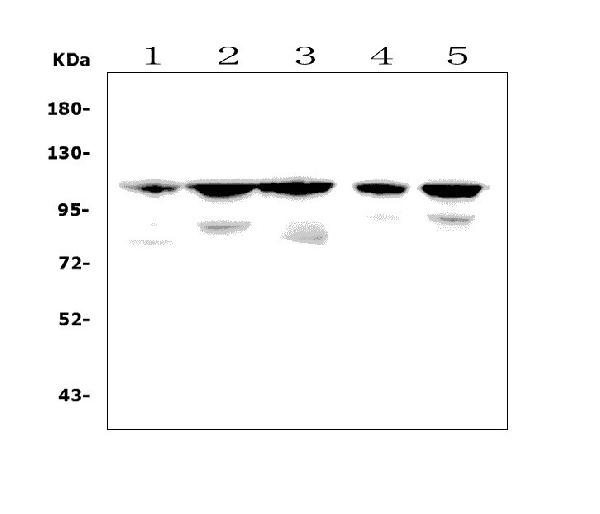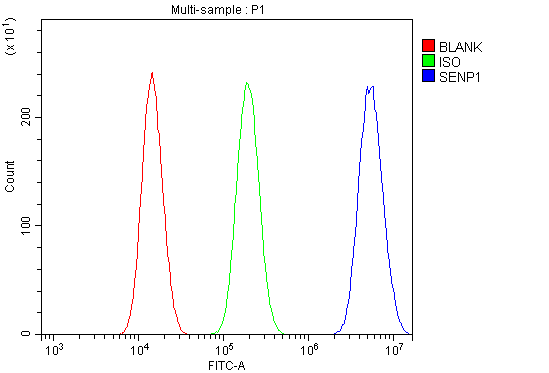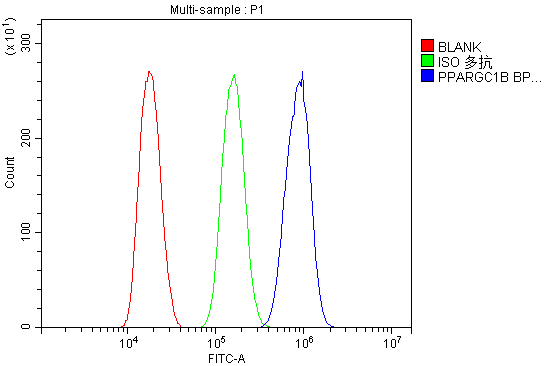| Western blot (WB): | 1:500-2000 |
| Flow Cytometry (Fixed): | 1:50-200 |
| Enzyme linked immunosorbent assay (ELISA): | 1:100-1000 |

Western blot analysis of PGC1 Beta/PPARGC1B using anti-PGC1 Beta/PPARGC1B antibody (A02933-1). The sample well of each lane was loaded with 30 ug of sample under reducing conditions.
Lane 1: human Caco-2 whole cell lysates,
Lane 2: human HEK293 whole cell lysates,
Lane 3: human U2OS whole cell lysates,
Lane 4: human MDA-MB-453 whole cell lysates,
Lane 5: human K562 whole cell lysates.
After electrophoresis, proteins were transferred to a membrane. Then the membrane was incubated with rabbit anti-PGC1 Beta/PPARGC1B antigen affinity purified polyclonal antibody (A02933-1) at a dilution of 1:1000 and probed with a goat anti-rabbit IgG-HRP secondary antibody (Catalog # BA1054). The signal is developed using ECL Plus Western Blotting Substrate (Catalog # AR1197). A specific band was detected for PGC1 Beta/PPARGC1B at approximately 113 kDa. The expected band size for PGC1 Beta/PPARGC1B is at 113 kDa.

Flow Cytometry analysis of U937 cells using anti-PGC1 Beta/PPARGC1B antibody (A02933-1).
Overlay histogram showing U937 cells stained with A02933-1 (Blue line). To facilitate intracellular staining, cells were fixed with 4% paraformaldehyde and permeabilized with permeabilization buffer. The cells were blocked with 10% normal goat serum. And then incubated with rabbit anti-PGC1 Beta/PPARGC1B Antibody (A02933-1) at 1:100 dilution for 30 min at 20°C. DyLight®488 conjugated goat anti-rabbit IgG (BA1127) was used as secondary antibody at 1:100 dilution for 30 minutes at 20°C. Isotype control antibody (Green line) was rabbit IgG at 1:100 dilution used under the same conditions. Unlabelled sample without incubation with primary antibody and secondary antibody (Red line) was used as a blank control.

Flow Cytometry analysis of Hepa1-6 cells using anti-PGC1 Beta/PPARGC1B antibody (A02933-1).
Overlay histogram showing Hepa1-6 cells stained with A02933-1 (Blue line). To facilitate intracellular staining, cells were fixed with 4% paraformaldehyde and permeabilized with permeabilization buffer. The cells were blocked with 10% normal goat serum. And then incubated with rabbit anti-PGC1 Beta/PPARGC1B Antibody (A02933-1) at 1:100 dilution for 30 min at 20°C. DyLight®488 conjugated goat anti-rabbit IgG (BA1127) was used as secondary antibody at 1:100 dilution for 30 minutes at 20°C. Isotype control antibody (Green line) was rabbit IgG at 1:100 dilution used under the same conditions. Unlabelled sample without incubation with primary antibody and secondary antibody (Red line) was used as a blank control.

Western blot analysis of PGC1 Beta/PPARGC1B using anti-PGC1 Beta/PPARGC1B antibody (A02933-1). The sample well of each lane was loaded with 30 ug of sample under reducing conditions.
Lane 1: human Caco-2 whole cell lysates,
Lane 2: human HEK293 whole cell lysates,
Lane 3: human U2OS whole cell lysates,
Lane 4: human MDA-MB-453 whole cell lysates,
Lane 5: human K562 whole cell lysates.
After electrophoresis, proteins were transferred to a membrane. Then the membrane was incubated with rabbit anti-PGC1 Beta/PPARGC1B antigen affinity purified polyclonal antibody (A02933-1) at a dilution of 1:1000 and probed with a goat anti-rabbit IgG-HRP secondary antibody (Catalog # BA1054). The signal is developed using ECL Plus Western Blotting Substrate (Catalog # AR1197). A specific band was detected for PGC1 Beta/PPARGC1B at approximately 113 kDa. The expected band size for PGC1 Beta/PPARGC1B is at 113 kDa.

Flow Cytometry analysis of U937 cells using anti-PGC1 Beta/PPARGC1B antibody (A02933-1).
Overlay histogram showing U937 cells stained with A02933-1 (Blue line). To facilitate intracellular staining, cells were fixed with 4% paraformaldehyde and permeabilized with permeabilization buffer. The cells were blocked with 10% normal goat serum. And then incubated with rabbit anti-PGC1 Beta/PPARGC1B Antibody (A02933-1) at 1:100 dilution for 30 min at 20°C. DyLight®488 conjugated goat anti-rabbit IgG (BA1127) was used as secondary antibody at 1:100 dilution for 30 minutes at 20°C. Isotype control antibody (Green line) was rabbit IgG at 1:100 dilution used under the same conditions. Unlabelled sample without incubation with primary antibody and secondary antibody (Red line) was used as a blank control.

Flow Cytometry analysis of Hepa1-6 cells using anti-PGC1 Beta/PPARGC1B antibody (A02933-1).
Overlay histogram showing Hepa1-6 cells stained with A02933-1 (Blue line). To facilitate intracellular staining, cells were fixed with 4% paraformaldehyde and permeabilized with permeabilization buffer. The cells were blocked with 10% normal goat serum. And then incubated with rabbit anti-PGC1 Beta/PPARGC1B Antibody (A02933-1) at 1:100 dilution for 30 min at 20°C. DyLight®488 conjugated goat anti-rabbit IgG (BA1127) was used as secondary antibody at 1:100 dilution for 30 minutes at 20°C. Isotype control antibody (Green line) was rabbit IgG at 1:100 dilution used under the same conditions. Unlabelled sample without incubation with primary antibody and secondary antibody (Red line) was used as a blank control.




